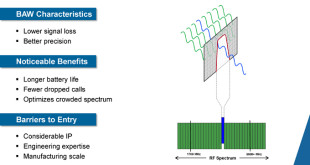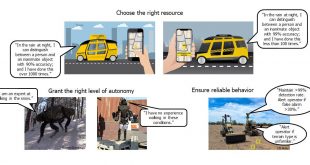Conventional optical fibers are fabulously successful, but they have profound limitations. They contain a glass core at the center of the fiber through which light is transmitted. However, not only does this glass center limit the speed of the light as it passes through, but it also adversely affects other …
Read More »DARPA GRIT program developing compact, tunable Gamma ray source for advanced accelerator technology, high-energy laser systems, and new x-ray and gamma ray detectors
Gamma rays are ionizing electromagnetic radiation, obtained by the decay of an atomic nucleus. Gamma rays are given off by stars, and by some radioactive substances. Gamma-rays travel to us across vast distances of the universe, only to be absorbed by the Earth’s atmosphere. Different wavelengths of light penetrate the Earth’s …
Read More »Surface-acoustic-wave (SAW) and bulk-acoustic-wave (BAW) Filters will be disruptor in the military RF and microwave industries
The complexity of current 4G/5G phones comes from the need to cover multiple bands. Modern modems like the ones used in mobile phones are compatible with multiple transmission bands, including 3G, 4G LTE, Wi-Fi, and Bluetooth. The radio frequency front-end (RFFE) section of cellphone includes components like antennas, LNAs, filters, …
Read More »Threats of hacking of digital IDs, driving develpment of unbreakable Quantum EPUF IDs containing 1,000 trillion atoms
We live in digitised, connected societies, in an Internet of Things (IoT) world where our reliance on software, hardware, and the networks that connect us, grows exponentially. Our increasing global reliance on what we hope and assume are secure networks, is profound. The threat of large-scale cyber-attack has become a …
Read More »Scientists solving major challenge of decoherence in turning quantum technology from potential to reality
‘The development of a “quantum computer” is one of the outstanding technological challenges of the 21st century. A quantum computer is a machine that processes information according to the rules of quantum physics, which govern the behaviour of microscopic particles at the scale of atoms and smaller. Quantum computers gain …
Read More »Rising importance of Non- Acoustic detection technologies of Stealthy submarines in Anti Submarine Warfare
Ship detection for offshore production operations, military activities, transportation and other marine applications is very important. Submarine is one of the most important weapon in modern wars. strategic submarines seem to be key to strategic stability, providing what is generally believed to be the most survivable nuclear second-strike force. Anti-submarine …
Read More »DARPA A-Teams, CAML & ADAPT programs developing efficient Agile Human-Machine Teams to execute battlefield, cyber and electronic warfare missions
The prime aim of US third offset strategy, announced in November 2014, was to develop effective strateges against multiple potential competitors, from small regional states like North Korea and Iran, to large advanced states like Russia and China, to non-state adversaries and actors with advanced capabilities. In response to third …
Read More »Indian Ocean maritime security threats and Indian Navy’s Maritime Domain Awareness (MDA) technology requirements and solutions
Indian Ocean has always been vulnerable to criminals and anti-national activities. The Indian Ocean is an area of conflict. According to a recent analysis of global conflicts by the Heidelberg Institute for International Conflict Research, altogether 42% of world conflicts can be associated with Indian Ocean countries. Numerous cases of the …
Read More »Countries developing Asteroid mining technologies
Early evidence suggests that there are trillions of dollars’ worth of minerals and metals buried in asteroids that come close to the Earth. These include phosphorus, antimony, zinc, tin, lead, indium, silver, gold and copper. The mining of resources contained in asteroids, for use as propellant, building materials or in …
Read More »DARPA CHARIOT developing Quantum proof cryptography for Military Mobile and IoT security
The exponential price/performance improvements in semiconductor technology stemming from Moore’s Law are enabling even the smallest and most application-specific devices, such as sensors and actuators, to include networking capabilities. The overwhelming majority of such devices will be cheap and power-constrained. Low device costs permit deployment in unprecedented numbers, with some …
Read More » International Defense Security & Technology Your trusted Source for News, Research and Analysis
International Defense Security & Technology Your trusted Source for News, Research and Analysis









